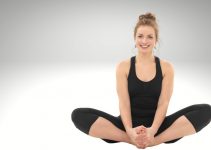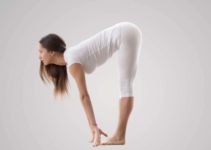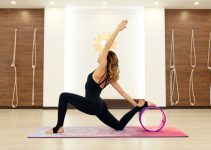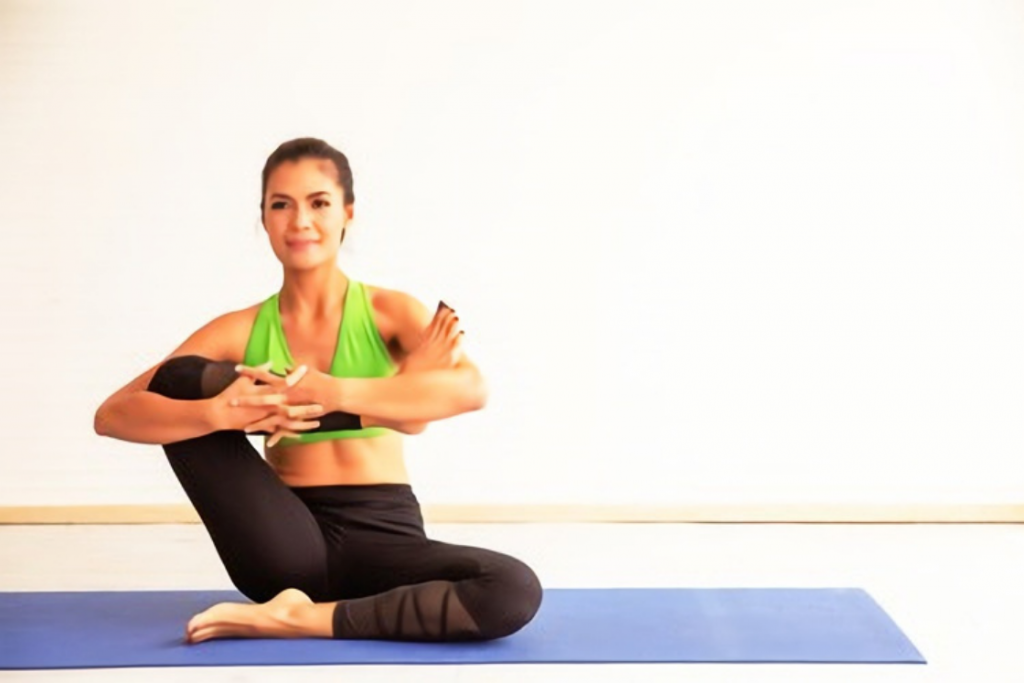
Your yoga sessions are supposed to begin with a number of loosening or warm-up exercises. The reason is by loosening, your body prepares itself for more intense practices. Hindolasana or the baby cradle pose is one such warm-up exercise that is useful for loosening your hip muscles.
Baby cradle pose mainly aims to open up the lower body so it focuses on gently stretching the hamstrings, pelvic floor muscles, groins, and gluteus maximus muscles. It’s performed in seated posture.
In this one leg is held crossway in front of the chest by both your hands just like a mother would hold a baby. Then, the legs swing left and right as the baby’s cradle moves.
Hindolasana Meaning
The Sanskrit word Hindola means a swinging cradle. Hindolasana thus translates as baby cradle pose, which takes a form like a swinging cradle. This pose is also known as leg cradle pose, rock the baby pose, seated cradle pose, knee rocking pose.
Hindolasana acts as a preparatory asana for more advanced sitting postures like Ardha-kapotasana (half-pigeon pose), Ananda balasana (happy child pose), gomukhasana (cow face pose), and their variations.
Its significance as a yoga posture is in terms of both physical and mental improvements. Hindolasana releases muscle tension in the lower body parts like hamstrings, knees, thighs, and calves. Also, it offers mental benefits of improved focus and relieves stress.
Practice Guide of Hindolasana
Hindolasana is a posture, usually performed as a hip-opening exercise to free the muscles from the legs, hips, and pelvic region. It is a pose done in a sitting position and has a set of indications before practising.
Contraindications
Avoid or do baby cradle pose with precautions in the following conditions;
- People who have recently undergone knee or hip surgery should avoid practicing Hindolasana.
- People with lower back or spine injuries should practice Hindolasana under the expert’s guidance, taking necessary precautions.
- Those suffering from arthritis of the hip, knees, and spine should practice Hindolasana while sitting on a cushion or a chair.
Preparatory Poses
- Sukhasana (easy pose)
Cradle Pose Steps
- Sit in Sukhasana (easy pose) with your legs crossed. Sit straight and keep your spine erect.
- Bring your right leg closer to your chest, the right knee should be outside of the chest. Try to draw the right knee as close to the chest as you can. The left foot should be folded the same way in Sukhasana.
- Now hold the folded right leg with your right crux of the elbow and support it with the left hand. Your both hands should hold your right leg closer to the chest. Bring the position of the right leg to be parallel to the floor.
- Now slowly start cradling swinging your right leg inward and outward with both the hands as if you were swinging a baby.. Maintain a normal breathing pattern while practicing rocking.
- Maintain the posture with cradling movement for around 8 to 10 breaths.
- You can switch sides and perform the same sequence with the left leg.
Follow-up Poses
Tips for Beginners
Beginners should ensure the slow and rhythmic movement in baby cradle pose. Even if it is a beginner’s level asana, cradling your legs fast can result in cramps in the legs or hip region.
Try to bring your leg as close as you can to your chest. This is important for stretching and feeling the effects of the asana in the abdominal region. Place a folded blanket under the respective hip to lift the folded leg further up.
A practitioner is required to maintain normal breathing after reaching the final stage of asana. If you feel any difficulty after practising Hindolasana like pains or cramps, kindly consult a trained yoga teacher.
Variations
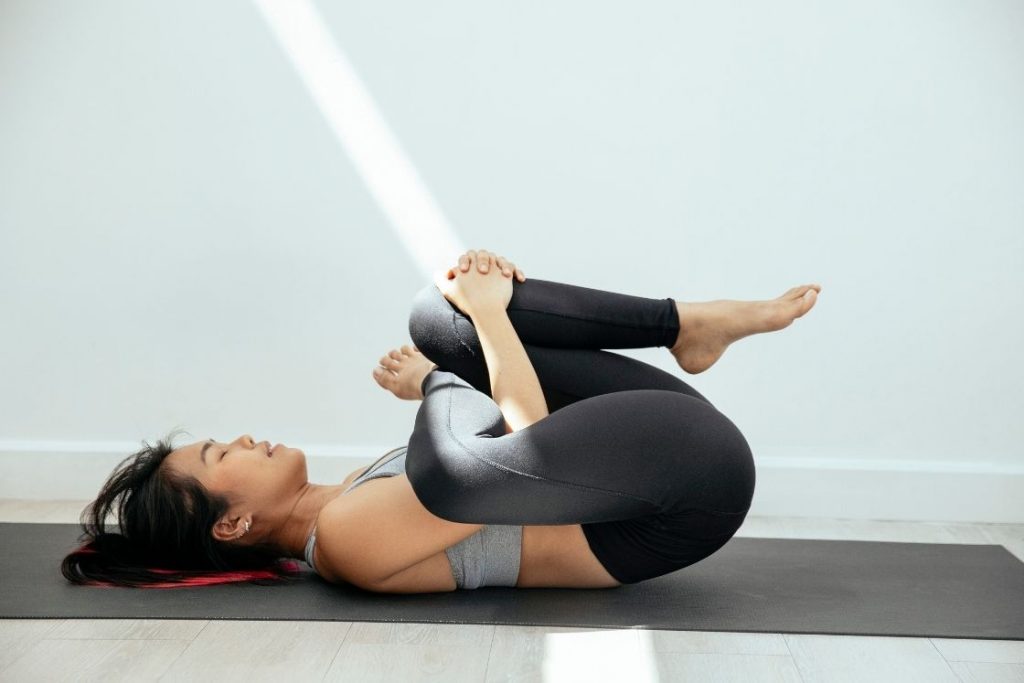
In the first variation, after practising Hindolasana by the right leg, straighten it on the floor and raise it from front with toes fingers pointing towards the ceiling. Support your knee with the right hand and keep steady in the position for a few seconds with normal breathing. Lower the leg in the easy pose slowly and practice the same sequence by the left leg.
In the second variation, while remaining seated in Sukhasana (easy pose), slowly start twisting your neck and shoulders from the waist and turn towards the backside. Perform these twists from right to left by slowly increasing the speed. As you turn to your right, your right arms should touch the ground on the right side and the same on the left.
Another variation of Hindolasana is to raise the right leg in front of your chest and form Anjali mudra around your right leg. Your left leg will be folded as in Sukhasana. Stay steady in the posture for 8-10 breaths and release the posture. You can perform the same with the left leg.
In the next variation, you can simply raise your right leg in front of the chest and wrap your arms around it. Keep your other leg (left) stretched out in the front. After 8-10 normal breaths, change the leg and practice the posture with the left leg, stretching out the right one in the front.
Reclined cradle posture is performed by laying on the back. The legs are bent from the knees, with both the feet touching the ground. Now cross your right ankle on the left thigh and start pushing it away from the body as you exhale.
Now take a breath and draw your knee again closer to your chest and with exhalation press it away from the body. Perform this practice with normal breathing a few times and then switch the side.
Benefits of Hindolasana
1. Promotes Spinal Flexibility and Balance
Hindolasana posture requires your lower body to release tension. The back-and-forth movements of your knees and thighs result in the flexibility of the lower part.
Moreover, Hindolasana is a type of balancing asana that requires attentive balance as your one knee is above the ground. Hence, its practice is also beneficial for maintaining balance in your lower body.
2. Strengthens the Muscles of the Lower Body
The movements of the lower body parts enhance the muscle power in that region. Hindolasana eases the muscle tension in the lower body parts and helps free the muscles of hips, knees, thighs, and calves.
Regular practice of this asana results in strengthening of the muscles in the lower part of your body. Your legs become stronger for practicing more advanced asanas.
3. Stimulates the Reproductive and Digestive Systems
As the pressure is built on the pelvic region of the body, the systems over there see a great improvement. Hindolasana stimulates the reproductive as well as digestive functions and helps them work fine.
4. Burns the Fats
The sidewise movements of Hindolasana contract and expand the abdominal and hip regions, thereby reducing the fat cells over there.
5. Develops Mental Focus
Hindolasana being the asana requiring physical as well as mental balance helps develop mental focus. Its regular practice benefits a person with enhanced concentration.
Conclusion
Hindolasana is a beginner’s yoga pose that is useful for stretching and strengthening the lower part of your body. It also acts as a preparatory practice for various intense exercises like running.
Include Hindolasana in your daily yoga sequence and you will observe lightness as well as strength in your hips, thighs, and abdomen.
